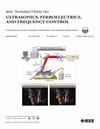无监督测试时间适应肝脂肪变性分级使用超声b型图像。
IF 3.7
2区 工程技术
Q1 ACOUSTICS
IEEE transactions on ultrasonics, ferroelectrics, and frequency control
Pub Date : 2025-03-26
DOI:10.1109/TUFFC.2025.3555180
引用次数: 0
摘要
由于其无创性和可用性,超声被认为是肝脂肪变性(即脂肪肝)临床评估的关键方式。深度学习方法在该领域引起了相当大的兴趣,因为它们能够在图像集合中学习模式,并在脂肪变性分级中达到临床可比的准确性水平。然而,不同临床站点的患者群体、获取协议、设备和操作人员专业知识的变化可能会导致领域转移,从而降低模型在原始培训环境之外的性能。因此,人们正在研究无监督域适应技术来解决这些变化,使模型能够更有效地在不同的临床环境中进行推广。在这项工作中,我们提出了一种测试时间批归一化技术,旨在通过在训练好的卷积神经网络模型中适应批归一化层的选定特征来处理域移位,特别是标签分布的变化。这种方法以无监督的方式运行,允许在不访问标签数据的情况下健壮地适应新的发行版。该方法在不同机构收集的两个腹部超声数据集上进行了评估,以评估其减轻肝脂肪变性分类的域移位的能力。与非适应模型相比,该方法将脂肪变性分级的平均绝对误差降低了37%,并将脂肪变性检测的受试者工作特征曲线下面积从0.78提高到0.97。这些发现证明了所提出的方法在基于超声的肝脂肪变性诊断中解决域转移的潜力,最大限度地降低了在各种临床环境中部署训练模型的风险。本文章由计算机程序翻译,如有差异,请以英文原文为准。
Unsupervised Test-Time Adaptation for Hepatic Steatosis Grading Using Ultrasound B-Mode Images
Ultrasound (US) is considered a key modality for the clinical assessment of hepatic steatosis (i.e., fatty liver) due to its noninvasiveness and availability. Deep learning methods have attracted considerable interest in this field, as they are capable of learning patterns in a collection of images and achieve clinically comparable levels of accuracy in steatosis grading. However, variations in patient populations, acquisition protocols, equipment, and operator expertise across clinical sites can introduce domain shifts that reduce model performance when applied outside the original training setting. In response, unsupervised domain adaptation techniques are being investigated to address these shifts, allowing models to generalize more effectively across diverse clinical environments. In this work, we propose a test-time batch normalization (TTN) technique designed to handle domain shift, especially for changes in label distribution, by adapting selected features of batch normalization (BatchNorm) layers in a trained convolutional neural network model. This approach operates in an unsupervised manner, allowing robust adaptation to new distributions without access to label data. The method was evaluated on two abdominal US datasets collected at different institutions, assessing its capability in mitigating domain shift for hepatic steatosis classification. The proposed method reduced the mean absolute error in steatosis grading by 37% and improved the area under the receiver operating characteristic curves (AUC) for steatosis detection from 0.78 to 0.97, compared to nonadapted models. These findings demonstrate the potential of the proposed method to address domain shift in US-based hepatic steatosis diagnosis, minimizing risks associated with deploying trained models in various clinical settings.
求助全文
通过发布文献求助,成功后即可免费获取论文全文。
去求助
来源期刊
CiteScore
7.70
自引率
16.70%
发文量
583
审稿时长
4.5 months
期刊介绍:
IEEE Transactions on Ultrasonics, Ferroelectrics and Frequency Control includes the theory, technology, materials, and applications relating to: (1) the generation, transmission, and detection of ultrasonic waves and related phenomena; (2) medical ultrasound, including hyperthermia, bioeffects, tissue characterization and imaging; (3) ferroelectric, piezoelectric, and piezomagnetic materials, including crystals, polycrystalline solids, films, polymers, and composites; (4) frequency control, timing and time distribution, including crystal oscillators and other means of classical frequency control, and atomic, molecular and laser frequency control standards. Areas of interest range from fundamental studies to the design and/or applications of devices and systems.

 求助内容:
求助内容: 应助结果提醒方式:
应助结果提醒方式:


